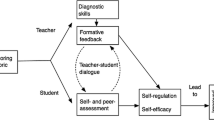Abstract
This paper promotes the use of adapted primary literature as a curriculum and instruction innovation for use in high school. Adapted primary literature is useful for promoting an understanding of scientific and mathematical reasoning and argument and for introducing modern science into the schools. We describe a prototype adapted from a published article on a mathematical model of the spread of the West Nile virus in North America. The prototype is available as a web-based resource that includes supplemental pedagogical units. Preliminary feedback from use of the prototype in two classrooms is described and a sketch of an ongoing formal evaluation is provided.





Similar content being viewed by others
References
Almeida, C. A., et al. (2005). Organic chemistry of the cell: an interdisciplinary approach to learning with a focus on reading, analyzing, and critiquing primary literature. Journal of Chemical Education, 82, 1794–9.
Baram-Tsabari, A., & Yarden, A. (2005). Text genre as a factor in the formation of scientific literacy. Journal of Research in Science Teaching, 42, 403–428.
Falk, H., Brill, G., & Yarden, A. (2008). Teaching a biotechnology curriculum based on adapted primary literature. International Journal of Science Education, 30, 1841–1866.
Fikes, L. E. (1989). Advanced organic chemistry: learning from the primary literature. Journal of Chemical Education, 66, 920–1.
Gallagher, G. J., et al. (2002). Introduction to the use of primary organic chemistry literature in an honors sophomore-level organic chemistry course. Journal of Chemical Education, 79, 1368–71.
Hoskins, S. G., et al. (2007). Selective use of the primary literature transforms the classroom into a virtual laboratory. Genetics, 176(3), 1381–9.
Suppe, F. (1998). The structure of a scientific paper. Philosophy of Science, 65, 381–405.
von Aufschnaiter, C., Erduran, S., Osborne, J., & Simon, S. (2008). Arguing to learn and learning to argue: case studies of how students’ argumentation relates to their scientific knowledge. Journal of Research in Science Teaching, 45, 101–131.
Wonham, M. (2004). The mathematics of mosquitoes and West Nile virus. Pi in the sky, 8, 5–9.
Wonham, M., de-Camino-Beck, T., & Lewis, M. (2004). An epidemiological model for West Nile virus: Invasion analysis and control applications. Proceedings of the Royal Society of London B, 271, 501–507.
Author information
Authors and Affiliations
Corresponding author
Rights and permissions
About this article
Cite this article
Norris, S.P., Macnab, J.S., Wonham, M. et al. West Nile Virus: Using Adapted Primary Literature in Mathematical Biology to Teach Scientific and Mathematical Reasoning in High School. Res Sci Educ 39, 321–329 (2009). https://doi.org/10.1007/s11165-008-9112-y
Received:
Accepted:
Published:
Issue Date:
DOI: https://doi.org/10.1007/s11165-008-9112-y




